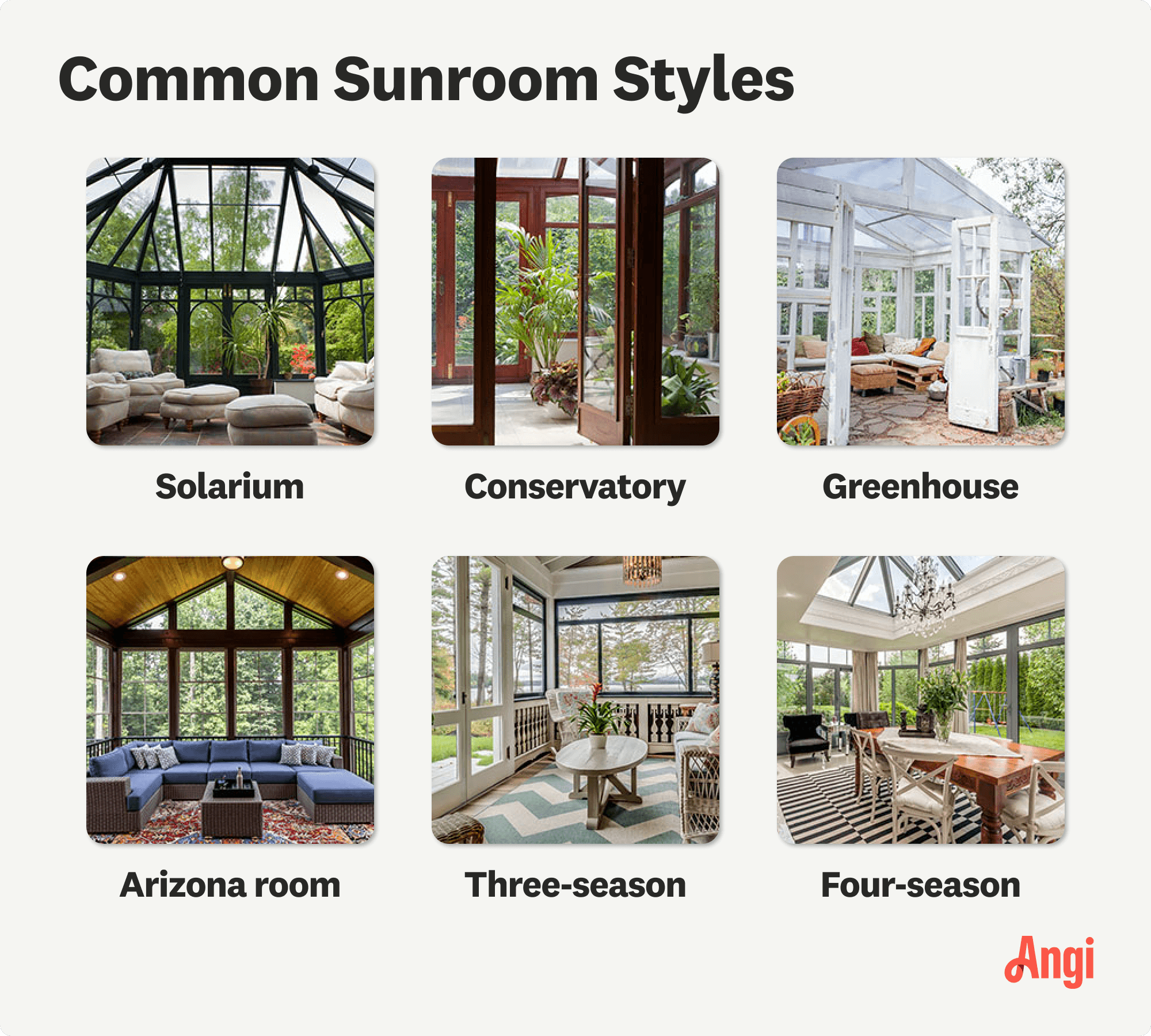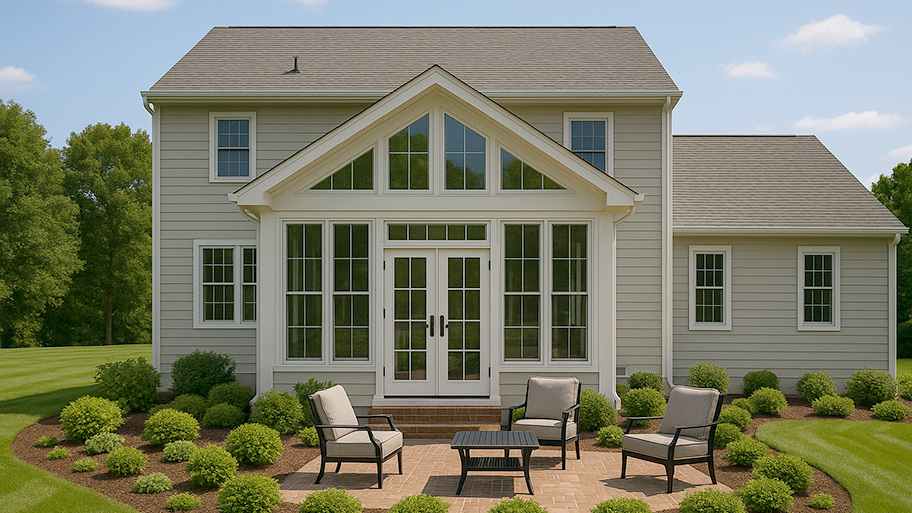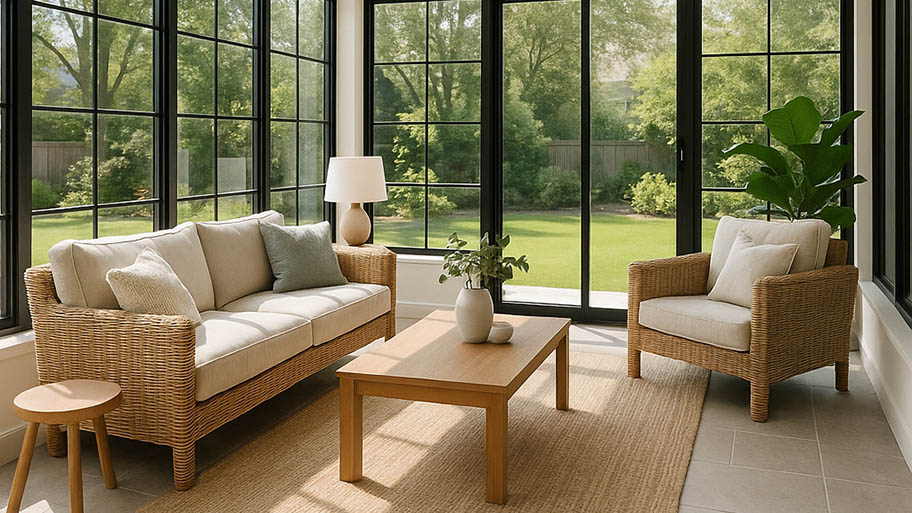
Considering adding a screened porch to your home? Discover the average cost of a screened-in porch, depending on its size, location, and more.
Sunroom addition costs range from $22,000 to $75,000, with an average of $47,000 depending on size and materials.


The size and type of sunroom you choose are the two biggest cost factors.
Materials play an important role, too, and high-end options add thousands.
Converting a porch or deck to a sunroom is more affordable than a new build.
Prefabricated sunrooms are half the price but provide less flexibility.
A sunroom addition costs an average of $47,000, and most projects total between $22,000 and $75,000. You could pay as little as $6,000 for a small, prefabricated sunroom, and prices can climb as high as $120,000 for a large, custom sunroom with high-end finishes. The cost depends on several factors, including the type of sunroom you want, the quality of materials, and the size of the addition.
“A sunroom is a wonderful, low-cost addition to a house,” says Bob Tschudi, an Expert Review Board Member and general contractor based in Raleigh, N.C. “In addition to being aesthetically pleasing, these structures extend your living space in an economical way.”
| Dimensions (Ft.) | Cost Range |
|---|---|
| 5 x 10 | $7,500 – $15,000 |
| 10 x 10 | $15,000 – $30,000 |
| 10 x 12 | $18,000 – $36,000 |
| 12 x 12 | $21,600 – $43,200 |
| 14 x 14 | $29,400–$58,800 |
| 10 x 20 | $30,000 – $60,000 |
| 12 x 20 | $36,000 – $72,000 |
| 20 x 20 | $60,000 – $120,000 |
On average, it costs between $150 and $300 per square foot to build a sunroom, although you could pay as little as $100 per square foot for a prefabricated sunroom.
Where inside this range your price falls depends on a number of factors, including the type of sunroom you’re building. Generally, four-season rooms and conservatory costs are on the higher end of the spectrum, while three-season sunrooms, glass solariums, and screened-in porches or Arizona rooms are on the lower end.
The average sunroom size is 12 feet by 14 feet or 168 square feet, so you can use that as a reference point to get a rough estimate for your sunroom dimensions and cost. Smaller sunrooms will cost less, while each additional square foot will add to your total.

The type of sunroom you choose will play a major role in your installation costs. Something like a four-season sunroom includes insulation and electrical connections and requires temperature control. The added building materials and labor to install heating and cooling equipment drive up the cost. On the other end of the spectrum, a screened-in porch has screens instead of windows, lacks finished walls and insulation, and doesn’t need heating, cooling, or electrical connections, so it will be a far more affordable option.
| Type of Sunroom | Cost Range |
|---|---|
| Arizona room | $2,000–$22,000 |
| Conservatory | $6,000–$80,000 |
| Three-season room | $10,000–$40,000 |
| Four-season room | $25,000–$120,000 |
| Greenhouse | $6,000–$10,000 |
| Prefabricated sunroom | $6,000–$40,000 |
| Solarium | $30,000–$75,000 |
Labor accounts for between 40% and 60% of your total sunroom addition cost, or between $18,800 and $28,200. Labor costs vary widely based on your area, the demand for sunroom construction when you’re ready to start, the complexity of your design, and more.
A sunroom contractor will be the best choice for a sunroom addition for a few reasons: they are familiar with all build aspects, they often have a full team of in-house professionals who can complete the tackle from start to finish, and they finish products significantly faster than a group of individuals that you or a general contractor might hire separately. Hiring a general contractor will cost an additional 20%, but it is another option if you don’t have dedicated sunroom pros in your area.
[For a home addition], we charge piece-by-piece for the project, then we add our profit and overhead. For example, lumber for the project, permits, demolition, electrical, plumbing, and drywall. I add them up and then add our profit and overhead. On smaller jobs, we work by the hour and then add the material on top of that.
Dedicated sunroom contractors will be able to handle your entire project from start to finish in most cases. Below are the average costs for different contractors you may need to hire if you go with a general contractor or hire the individual professionals yourself.
Electrician cost: $50–$130 per hour
HVAC tech cost: $100–$250 per hour
Plumber cost: $45–$200 per hour
Framing professional cost: $7–$16 per square foot
Roofer cost: $4–$11 per square foot
Window installer cost: $300–$2,500 per window
Foundation expert cost: $5–$37 per square foot
Flooring installer cost: $2–$20 per square foot
Landscaper cost: $50–$100 per hour
The cost of a sunroom depends on where you live, mostly because labor costs fluctuate based on the cost of living. Prices will tend to be higher in coastal states and near major metropolitan areas. You’ll also see higher costs in areas where the demand is higher, like Southern California, Arizona, Florida, and Texas.
| State | Average Cost |
|---|---|
| California | $68,000 |
| Florida | $48,100 |
| Georgia | $43,000 |
| Illinois | $44,900 |
| Michigan | $43,400 |
| New York | $58,000 |
| North Carolina | $45,900 |
| Ohio | $44,600 |
| Pennsylvania | $44,600 |
| Texas | $43,500 |

There are many sunroom ideas to choose from, and each alters the final price tag. Sunroom costs come down to its size, construction permits, structural elements, and all the fixtures that give it style.
The materials you choose for every part of your sunroom will play an important role in your total, and that all starts with the primary construction materials. You have a few options.
| Construction Material | Average Cost Range |
|---|---|
| Acrylic | $5,000–$30,000 |
| Aluminum | $6,000–$60,000 |
| Steel | $10,000–$80,000 |
| Vinyl | $5,000–$30,000 |
| Wood | $2,000–$120,000 |
The type of material you choose is largely determined by the type of sunroom you want. Aluminum and steel frame construction is common for solariums and screened-in porches, so the cost tends to be lower than wood construction, even though the materials themselves are more expensive.
If there’s no existing foundation to build on, expect to pay between $500 and $5,600 to clear the land and prepare the construction site. If you need trees removed you can expect to pay around $700 per tree, and land excavation comes in at a cost of $1,300 to $4,600.
Pouring the foundation for a new sunroom costs between $500 and $6,000, depending on the square footage. You may be able to forgo this expense if you’re converting a deck to a sunroom, but you’ll need a structural engineer to confirm that the deck and the footers below are structurally sound and will support the home addition.
Insulation costs between $500 and $1,500, depending on the materials and square footage of the room. Adding insulation is a key part of building a four-season sunroom, but you can ignore this expense for all other sunroom types, as they aren’t insulated.
Sunrooms need windows to let in natural light and doors to maintain access to nature and ventilation. Windows cost between $300 and $2,000 each, and expect costs toward the upper end of that range if you choose floor-to-ceiling windows. Patio door installation adds another $1,300 to $11,000, including labor and materials.
The cost to add heating and central air conditioning to your sunroom is $2,300 to $20,500. The price depends on the type of heating system you’re installing or tying into and the size of the sunroom. You’ll pay toward the lower end of that range to install a ductless mini-split system, while adding ductwork or baseboard heat will push toward the higher end. Note that heating and cooling are only features for four-season rooms.
Interior finishes can range from $200 to $9,000, based on how much you have planned for the interior design. Expect to spend $1,500 to $4,300 on various sunroom flooring ideas and $2 to $6 per square foot on painting. If you start planning well in advance, you can find good deals on furniture for the room, bringing your costs down.
If you’re hiring a general contractor to help with the construction of your new sunroom addition, the cleanup cost will usually be rolled into the total project price. However, if you’re cleaning up a construction yourself or want to hire a dedicated crew, plan on another $280 to $670. Dumpster rental and haul-away costs between $300 and $525.
Adding final cosmetic touches with landscaping costs between $1,400 and $5,500, depending on the services you need.
Any addition to your home requires a building permit, and sunrooms are no exception. Sunroom permits cost between $250 and $1,500. Acquiring a permit can take between two and eight weeks, and is an essential step in the process. This ensures that everything is up to code and meets insurance requirements.
“If you are working with a licensed general contractor, make sure that they are insured,” says Tschudi. “If you are a DIYer, contact your insurance agent to add coverage for your construction. That way, the materials, the subcontractors, and even your entire house is protected.”
Converting a porch to a sunroom will save you some money over building one from scratch. You can expect to pay between $41,500 and $46,000 for conversion while building a new sunroom costs an average of $47,000. You save some money because you don’t need to pay to pour a foundation. However, you will need a structural engineer to confirm whether the porch and the footers below can support the new sunroom.
This is a big job that involves structural adjustments to your home, so leave this project to a sunroom contractor near you to ensure the work is done safely and securely.
Adding to a home is a complex project that requires many different skill sets to complete. Here are the many reasons it’s best to hire a pro for a sunroom addition:
Building a sunroom will require filing for permits, which a contractor will know how to do. Not obtaining the proper permits can cause project delays and fines.
A sunroom contractor has the experience and training to safely build a sunroom that lasts.
Going with a pro over a DIY prefab kit means you have more options for customization.
If you want heat, power, or other utilities in your sunroom, a pro can safely install these add-ons.
A pro will ensure the addition is completely safe and up to local building codes and zoning requirements.
Improper DIY installation could lead to a weak and unsafe structure.
Pouring foundation and installing walls, doors, and a roof requires specialized skills and equipment that a pro will already have.
DIYing could void the warranties on some materials, like doors and windows.
There are a few DIY ways to save money and contribute to your new sunroom:
For handy homeowners, consider handling the installation of doors and windows rather than the entire sunroom.
For novice DIYers, work on smaller projects, like painting the interior walls.
Consider planting new grass seed or other plants around the new sunroom if you’d like to save on landscaping costs after construction.
There are plenty of ways to get creative and save money on sunroom additions. Not all sunrooms need to host a hoard of neighbors or offer year-round use. Here are some ways to keep costs in your budget.
Consider prefab sunroom designs.
Turn an existing space into a sunroom.
Opt for a smaller space.
Choose a more affordable Florida room addition to cut out the need for insulation, heating, and cooling.
Consider low-cost HVAC options such as mini splits if you splurge for a four-season room.
Consider more affordable types of sunrooms, like solariums and screened-in porches.
Speak with at least three designers to compare estimates.
Stick with a flexible timeline to allow contractors to find low-cost materials.
Consider long-term costs that will save you money on heating and upkeep over time.
Line up your sunroom with existing exterior doors.
Research DIYable finishes on your own for after the major construction phase.
Building a sunroom on a budget is possible, but it can be difficult to envision what each price range will get you. Garden rooms and conservatories, for example, are best for modest budgets around $5,000 to $10,000. Once you get above $20,000, consider building an atrium, a small three-season room, or a greenhouse on an existing structure. Between $30,000 and $75,000, break into the three and four-season rooms larger than 150 square feet.
While building a sunroom can be a costly endeavor, they have a 49% return on investment (ROI), which is on the high end for a home addition. As such, building a sunroom will increase your home’s value by half the cost of the addition. Whether you choose to make this addition during a home remodel or when taking on the cost to build a new house, it can be a wise one for your bottom line.
Plan where you want to install the sunroom addition based on sunlight considerations.
Discuss material and design options for walls, floors, the roof, windows, and doors.
Make a plan for where to install outlets if you’re adding electrical connections.
Ensure the contractor obtains proper permits and that utility providers and a plumber come to mark water, power, and gas lines.
Ask about the project timeline, and stay clear of the area during construction.
Home is the most important place on earth, which is why Angi has helped more than 150 million homeowners transform their houses into homes they adore. To help homeowners with their next project, Angi provides readers with the most accurate cost data and upholds strict editorial standards. We extensively research project costs to develop the pricing data you see, so you can make the best decisions for you and your home. We rely on reputable sources, including the U.S. Bureau of Labor Statistics, academic journals, market studies, and interviews with industry experts—all to ensure our prices reflect real-world projects.
Want to help us improve our cost data? Send us a recent project quote to [email protected]. Quotes and personal information will not be shared publicly.
From average costs to expert advice, get all the answers you need to get your job done.

Considering adding a screened porch to your home? Discover the average cost of a screened-in porch, depending on its size, location, and more.

While a solarium addition costs homeowners a fair amount of money, the return on investment is higher than most projects. Learn what affects the total cost and where you can save money.

How much does it cost to rescreen your porch or sunroom? Learn about screen materials, average labor costs, and other costs for rescreening your porch.

Both offer livable space in a home, but there are many differences between the two. Learn the pros and cons to decide between a sunroom and a room addition.

When it comes to a screened-in porch versus a 3-season room, there are some key differences. Learn about the costs and uses of each type of sunroom.

Dreaming of having a sunroom in your home but wondering who builds sunrooms? Here's what you need to know about hiring a pro to build a sunroom.